Land & Plants: 2016 Growth Awards
The Gregorian calendar year has increased by one, so that means it's time for the 5th Annual Growth Awards. Plants grow to propagate their DNA before they're physically outcompeted, but these awards reward those plants that impress me the most with their ability to quickly grow to their mature size or that best represent a Baton Rouge sense of place. Categories are the same as last year: Best Canopy Tree, Best Understory Tree, Best Shrub, Best Wildflower, Best Edible, Best Vine, Best Grass, and Best Fall Color.
Heights measurements were taken on December 29, 2016. Criteria vary per category but are generally the percentage increase in height from a year ago.
In Memory
With all gardening, there is death as well as life. It's the cycle of life, and the death of one individual is necessary for other individuals to live. (Bacteria and fungus break material down to be reused by other plants.) Let's take a look back at those plants that are no longer with us.
Mayhaw
Planted: 2014 October
I planted two mayhaw next to each other two years ago. For unknown reasons, one had a harder time of it and finally succumbed to death this year. The cause was probably consistent underwatering before it could get established.
Hackberry
Planted: (volunteer circa 2013)
Common hackberries pop up all over the yard, and I left two alone to grow up for three or so years. But they get quite large and the location wasn't suited for it, so I decided to saw them down in November.
Red maple (west)
Planted: 2011 December
One of the two red maples kinda plateaued, and I wanted a black tupelo somewhere. I therefore decided this one needed to be removed. On New Year's Day 2016, I dug it up and replaced it with a new tupelo. The maple has since died and been burned in a backyard fire.
Biggest Scandal
There has been a scandal category for the past two years, but this year nothing bizarre and unexpected happened. While this is a good thing, it may leave you wishing for a repeat of previous years' drama.
Let's now begin the actual award categories.
Best Canopy Tree
First off, let's look at the tall trees that grow above all others. The primary criterion is percentage height increase from a year ago.
 Baldcypress
Current height: 7'9" (max: 80')
Planted: 2013 December
Baldcypress
Current height: 7'9" (max: 80')
Planted: 2013 December
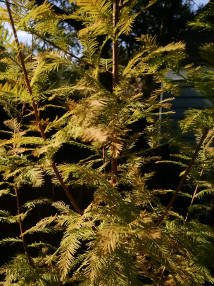 If you recall, I grew this from seed. It won the 2013 Best Canopy Category that year before being overpowered by the American sycamore for the past two years. This year, though, it managed to outperform the sycamore by growing 58% taller in a single year. That's almost 3 feet in a single year.
If you recall, I grew this from seed. It won the 2013 Best Canopy Category that year before being overpowered by the American sycamore for the past two years. This year, though, it managed to outperform the sycamore by growing 58% taller in a single year. That's almost 3 feet in a single year.
American sycamore
Current height: 11'2" (max: 90')
Planted: 2014 May
The winner of this category in 2014 and 2015 only increased by 47% in 2016. It's growing more each year, but because it's so tall the percentage increase is decreasing.
Red maple
Current height: 8'9" (max: 60')
Planted: 2011 December
The stronger of the two red maples (and the only one that is currently alive) only grew 28% in the past year, but this is enough to rank third place.
Shumard oak
Current height: 10'8" (max: 80')
Planted: 2015 November
A new entry to this category, the Shumard oak grew an unexpected 14" in since being planted. This is a modest 12%.
Tuliptree (north)
Current height: 5'2" (max: 100')
Planted: 2013 October
The northern tuliptree has caught up with the southern tree, growing 11% taller. They are now the same height. This increase just beat out the black tupelo, which only grew 10%.
Best Understory Tree
These are shorter trees that grow under canopy trees or at the forest edge. Or maybe just by themselves. The primary criterion is how well they are filling out since height isn't everything in the understory.
 Eastern redcedar
Current height: 16'0" (max: 40')
Planted: 2011 October
Eastern redcedar
Current height: 16'0" (max: 40')
Planted: 2011 October
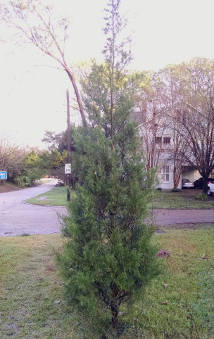 This guy has done well year after year, even though I've moved it from "Tall Tree, >20 feet" in 2012 to "Canopy Tree" in 2013 to "Understory Tree" in 2014. It's previously won first place twice, and wins again this year because of the combination of a 32% increase in height, its usefulness as a Christmas tree, its full shape, and its very interesting bark.
This guy has done well year after year, even though I've moved it from "Tall Tree, >20 feet" in 2012 to "Canopy Tree" in 2013 to "Understory Tree" in 2014. It's previously won first place twice, and wins again this year because of the combination of a 32% increase in height, its usefulness as a Christmas tree, its full shape, and its very interesting bark.
American hornbeam
Current height: ? (max: 40')
Planted: 2013 October
I really can't say how tall this tree grew because I can't get a measuring tape that high. It has a trunk that is starting to get characteristically ripply, but it has yet to fill out.
Eastern redbud (street-side)
Current height: 3'3" (max: 30')
Planted: 2015 January
While getting an impressive 63% taller, height alone wasn't enough to impress me over the other two higher-ranked trees in this category.
Cherry laurel
Current height: 2'10" (max: 40')
Planted: 2014 October
This plant has grown about the same amount in 2014, 2015, and 2016 (11"), but its percentage increase was only 48% this past year. Some might say it has been unfairly treated as it was completely ignored last year, but I remind you that these awards are mostly subjective.
Fringetree (middle)
Current height: 1'10" (max: 20')
Planted: 2014 April
Fringetrees historically don't make the nominations due to their slow growth, but this one's 47% increase got it in this time. (Though this will likely be the last time we see it as an awards nominees. Other plants will likely outperform it next year.)
Best Shrub
Not quite what I would call a tree due to their height and shape.
 Coralbean
Current height: ~6' (max: 6')
Planted: 2014 March
Coralbean
Current height: ~6' (max: 6')
Planted: 2014 March
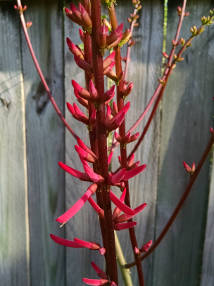 The two coralbeans in the back alley have reached what I imagine are full size. I didn't bother measuring them, but I figure they're in the 6-7' range. Because of their size, interesting leaf shape, and usefulness to hummingbirds, I thought they should both win the Best Shrub category.
The two coralbeans in the back alley have reached what I imagine are full size. I didn't bother measuring them, but I figure they're in the 6-7' range. Because of their size, interesting leaf shape, and usefulness to hummingbirds, I thought they should both win the Best Shrub category.
 Groundsel
Current height: 10'11" (max: 12')
Planted: 2014 May
Groundsel
Current height: 10'11" (max: 12')
Planted: 2014 May
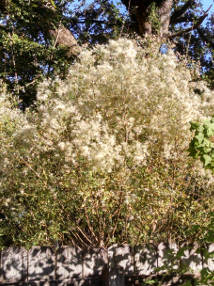 But not to be outdone, the original groundsel is equally impressive to me. It grew another 56% and was swamped by insects when it flowered this fall. That technically means three plants win this category this year.
But not to be outdone, the original groundsel is equally impressive to me. It grew another 56% and was swamped by insects when it flowered this fall. That technically means three plants win this category this year.
Arrowwood viburnum (west)
Current height: 6'6" (max: 8')
Planted: 2014 November
The arrowwood viburnums continue to do well as a group. This one grew 39%.
Arrowwood viburnum (east)
Current height: 2'8" (max: 8')
Planted: 2014 December
The shortest of the viburnums also grew 39%.
Virginia sweetspire (south)
Current height: 2'8" (max: 6')
Planted: 2014 August
The shorter of the two Virginia sweetspires grew 33%, rounding out this category for 2016.
Best Wildflower
Only native perennials and annuals allowed.
 Partridge pea
Sowed: 2013 March (originally)
Partridge pea
Sowed: 2013 March (originally)
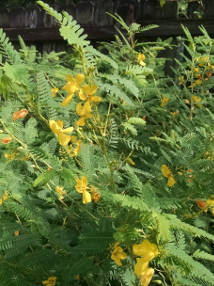 The 4th generation of this annual did their great-grandparents proud, drawing the admiration of native bees, wasps, and sulphur butterflies.
The 4th generation of this annual did their great-grandparents proud, drawing the admiration of native bees, wasps, and sulphur butterflies.
Scarlet sage
Sowed: 2015 August
Despite a long flowering season and their attractiveness to hummingbirds, I didn't feel these scarlet sage quite beat the winners of this category.
Blazing star
Planted: 2015 November
Larger bees were drawn to the flowers. This is a great addition, and I hope the abundance of seeds means this plant will pop up in other areas of the yard in 2017.
Swamp sunflower
Sowed: 2014 November
When the flowers bloom in fall, the plant is taller than me. Many bees visit and all is well.
Indian pink
Planted: 2015 December
I thought this one should beat out the penstemon and trillium because of how long it's taken me to get them to grow in my yard under the live oak. I hope they decide to come back in spring.
Best Edible
Things I can eat.
 Climbing cucumber
Climbing cucumber
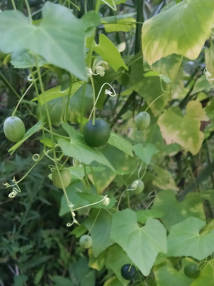 The winner turned out to be what others might call a weed. It's a delicate vine that gets tiny yellow flowers followed by miniature fruit that resemble watermelon but taste like cucumber. Just remember to eat them while they're still light green because they are poisonous once they turn black.
The winner turned out to be what others might call a weed. It's a delicate vine that gets tiny yellow flowers followed by miniature fruit that resemble watermelon but taste like cucumber. Just remember to eat them while they're still light green because they are poisonous once they turn black.
Yaupon
I was tempted to award first place to yaupon again as I do enjoy tea from its leaves, but the climbing cucumber is just so convenient to pick and eat.
Tuscan blue rosemary
Planted: 2011 November
This slowly dying plant barely beat out basil because of its age.
Basil
Sowed: 2016 March
I grew a new batch of basil from seed in March. They didn't get as big as I wanted probably because the soil I planted them in doesn't have enough organic matter.
Bay laurel
Planted: 2014 October
It was shaded by partridge pea this year, but that may be how it survived the crazy weather of this year's summer. Because I picked off a couple leaves, it just beat some edible ginger I planted in April (which I will only harvest in another year).
Best Vine
These grow up vertical things.
 Maypop
Planted: 2014 February
Maypop
Planted: 2014 February
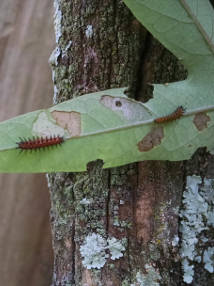 After two years of being nominated, the maypop finally wins this year because of its tenacity to grow way up a crepe myrtle, its value to fritillary caterpillars, and other vines' lackluster performance. It has yet to flower, though.
After two years of being nominated, the maypop finally wins this year because of its tenacity to grow way up a crepe myrtle, its value to fritillary caterpillars, and other vines' lackluster performance. It has yet to flower, though.
Climbing cucumber
Even though I eat its fruit, I really don't want to encourage this vine too much as it tends to grow very quickly.
Crossvine
Planted: 2014 December
The crossvine has reached the top of the fence, but it has yet to break out along the top and it didn't produce any flowers this year.
Virginia creeper
They are reliable as always, but I didn't see any fruit this year. Also, the weather didn't encourage much fall color.
Climbing hydrangea
Planted: 2015 October
This one makes the nominations because it's still alive. (I do have a virgin's bower, but it has slipped unnoticed behind some other plants.)
Best Grass
The competition for Best Grass has increased over previous years.
 Bushy bluestem
Sowed: (volunteer)
Bushy bluestem
Sowed: (volunteer)
 I identified the winner this year once it flowered. It's a tall, spectacular grass, and I don't know how it got to my yard. But I have spread its seeds around the yard so that I can help return it to this small patch of Baton Rouge.
I identified the winner this year once it flowered. It's a tall, spectacular grass, and I don't know how it got to my yard. But I have spread its seeds around the yard so that I can help return it to this small patch of Baton Rouge.
Gulf muhly
Planted: 2015 November
Three of the muhly grass plants exploded in pink flowers this year. What a great species.
Inland seaoats
Sowed: 2013 January
The inland seaoats continue to get established. The seedheads are pretty awesome.
Little bluestem
Sowed: 2016 March
I didn't expect such quick growth, but the little bluestem that I sowed in March not only grew tall but also flowered in the first year. Compared to broomsedge, the leaves are more purple and what I would call greyish green, which I can understand might appear blue to some.
Broomsedge
Broomsedge is the original grass in my yard, having won this category back in 2014. When it dies back in late fall or early winter, the leaves turn a straw color, making it very distinguishable from little bluestem.
Best Fall Color
This category returns this year and highlights all the ways fall colors can appear in south Louisiana.
 Flowering dogwood
Color: red
Planted: 2016 January
Flowering dogwood
Color: red
Planted: 2016 January
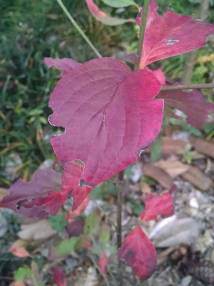 The weather this fall wasn't conducive to much fall color this year, and yet this new flowering dogwood stood out in bright red.
The weather this fall wasn't conducive to much fall color this year, and yet this new flowering dogwood stood out in bright red.
Winged sumac
Color: red
Planted: 2015 March
The winged sumac did well again as it reliably turns red according to changes in lighting and not temperature, but it was no match for the dogwood.
Shumard oak
Color: red
Planted: 2015 November
In the future, this oak will provide good color, but the temperatures just didn't cooperate this year. (All other plants faired much worse in this regard.)
Now let's see how my last year's predictions for top performers did in 2016.
2015's up-and-coming for 2016
Elderberry
Current height: ~7' (max: 10')
Sowed: 2016 July
Rating: very good
Two of the four elderberry grew quite tall — one even flowered! — but they are still too young to get bushy.
Red mulberry
Current heights: 1'1", 1'9" (max: 20')
Planted: 2014 December
Rating: fair
It could be that these two plants are still getting their roots established. Or it could be that they just don't like dappled shade all that much.
Crossvine
Planted: 2014 December
Rating: fair
Same thing goes for the crossvine: it could still be getting its roots established, but it did reach the top of the fence this year.
American beautyberry
Current height: [various] (max: 6')
Planted: [various]
Rating: good
Considering I grew these from cuttings or seed in early 2015, I think they are doing quite well now. There are something like 12 of them growing alongside the 4 I had previously bought in pots.
Possumhaw viburnum
Current height: 5'8" (max: 10')
Planted: 2016 October
Rating: poor
This plant did not grow in height or width. It had a few flowers and very little resulting fruit. It is likely still getting established.
2016's up-and-coming for 2017
And finally, to wrap up this awards show, I'd like to predict five potential break-out plants for 2017.
Red coral honeysuckle
Planted: 2016 October
It may be that it uses 2017 to grow its roots, much like what appears to be happening with the crossvine, but I think there's still a chance of some vertical growth up the fence.
American beautyberry patch
Current height: [various] (max: 6')
Planted: [various]
I think much of next growing season's above-ground growth will be with just a few shoots. This will allow me to prune next winter so that they can get nice and bushy. I also look forward to all the flowers and purple fruit. Fall will be even better next year.
Elderberry
Current height: ?' (max: 10')
Sowed: 2016 July
I'll prune them in the next couple months, and that should encourage more branching for 2017.
Yaupon (northwest)
Current height: 1'11" (max: 25')
Planted: 2016 December
I just planted a female to replace some shell ginger. It may be slow in 2017, but yaupons tend to be very fast growers under the right conditions.
Crossvine
Planted: 2014 December
I don't know this species very well, but its slow growth thus far might just be what happens when newly planted.
 Baldcypress
Current height: 7'9" (max: 80')
Planted: 2013 December
Baldcypress
Current height: 7'9" (max: 80')
Planted: 2013 December
 If you recall, I grew this from seed. It won the 2013 Best Canopy Category that year before being overpowered by the American sycamore for the past two years. This year, though, it managed to outperform the sycamore by growing 58% taller in a single year. That's almost 3 feet in a single year.
If you recall, I grew this from seed. It won the 2013 Best Canopy Category that year before being overpowered by the American sycamore for the past two years. This year, though, it managed to outperform the sycamore by growing 58% taller in a single year. That's almost 3 feet in a single year.
 Eastern redcedar
Current height: 16'0" (max: 40')
Planted: 2011 October
Eastern redcedar
Current height: 16'0" (max: 40')
Planted: 2011 October
 This guy has done well year after year, even though I've moved it from "Tall Tree, >20 feet" in 2012 to "Canopy Tree" in 2013 to "Understory Tree" in 2014. It's previously won first place twice, and wins again this year because of the combination of a 32% increase in height, its usefulness as a Christmas tree, its full shape, and its very interesting bark.
This guy has done well year after year, even though I've moved it from "Tall Tree, >20 feet" in 2012 to "Canopy Tree" in 2013 to "Understory Tree" in 2014. It's previously won first place twice, and wins again this year because of the combination of a 32% increase in height, its usefulness as a Christmas tree, its full shape, and its very interesting bark.
 Coralbean
Current height: ~6' (max: 6')
Planted: 2014 March
Coralbean
Current height: ~6' (max: 6')
Planted: 2014 March
 The two coralbeans in the back alley have reached what I imagine are full size. I didn't bother measuring them, but I figure they're in the 6-7' range. Because of their size, interesting leaf shape, and usefulness to hummingbirds, I thought they should both win the Best Shrub category.
The two coralbeans in the back alley have reached what I imagine are full size. I didn't bother measuring them, but I figure they're in the 6-7' range. Because of their size, interesting leaf shape, and usefulness to hummingbirds, I thought they should both win the Best Shrub category.
 Groundsel
Current height: 10'11" (max: 12')
Planted: 2014 May
Groundsel
Current height: 10'11" (max: 12')
Planted: 2014 May
 But not to be outdone, the original groundsel is equally impressive to me. It grew another 56% and was swamped by insects when it flowered this fall. That technically means three plants win this category this year.
But not to be outdone, the original groundsel is equally impressive to me. It grew another 56% and was swamped by insects when it flowered this fall. That technically means three plants win this category this year.
 Partridge pea
Sowed: 2013 March (originally)
Partridge pea
Sowed: 2013 March (originally)
 The 4th generation of this annual did their great-grandparents proud, drawing the admiration of native bees, wasps, and sulphur butterflies.
The 4th generation of this annual did their great-grandparents proud, drawing the admiration of native bees, wasps, and sulphur butterflies.
 Climbing cucumber
Climbing cucumber
 The winner turned out to be what others might call a weed. It's a delicate vine that gets tiny yellow flowers followed by miniature fruit that resemble watermelon but taste like cucumber. Just remember to eat them while they're still light green because they are poisonous once they turn black.
The winner turned out to be what others might call a weed. It's a delicate vine that gets tiny yellow flowers followed by miniature fruit that resemble watermelon but taste like cucumber. Just remember to eat them while they're still light green because they are poisonous once they turn black.
 Maypop
Planted: 2014 February
Maypop
Planted: 2014 February
 After two years of being nominated, the maypop finally wins this year because of its tenacity to grow way up a crepe myrtle, its value to fritillary caterpillars, and other vines' lackluster performance. It has yet to flower, though.
After two years of being nominated, the maypop finally wins this year because of its tenacity to grow way up a crepe myrtle, its value to fritillary caterpillars, and other vines' lackluster performance. It has yet to flower, though.
 Bushy bluestem
Sowed: (volunteer)
Bushy bluestem
Sowed: (volunteer)
 I identified the winner this year once it flowered. It's a tall, spectacular grass, and I don't know how it got to my yard. But I have spread its seeds around the yard so that I can help return it to this small patch of Baton Rouge.
I identified the winner this year once it flowered. It's a tall, spectacular grass, and I don't know how it got to my yard. But I have spread its seeds around the yard so that I can help return it to this small patch of Baton Rouge.
 Flowering dogwood
Color: red
Planted: 2016 January
Flowering dogwood
Color: red
Planted: 2016 January
 The weather this fall wasn't conducive to much fall color this year, and yet this new flowering dogwood stood out in bright red.
The weather this fall wasn't conducive to much fall color this year, and yet this new flowering dogwood stood out in bright red.